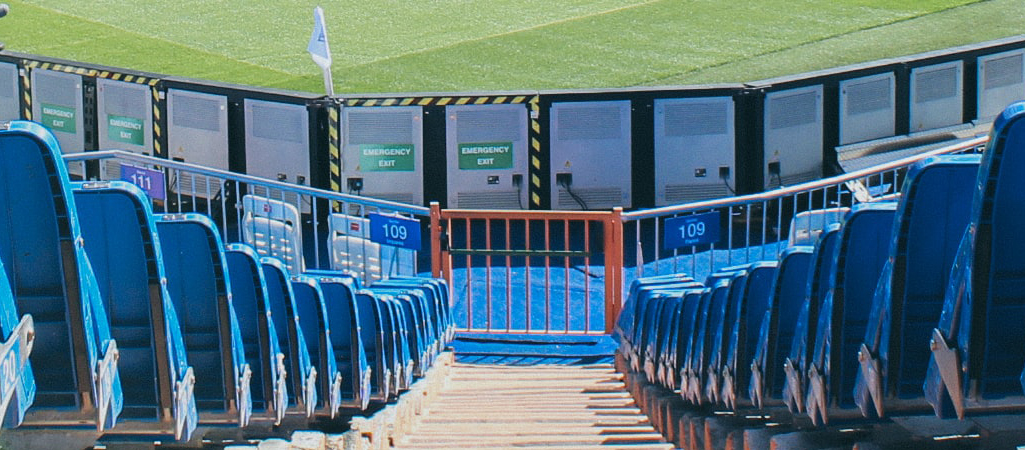
Spending $6 billion to build the world’s most state-of-the-art stadium doesn’t get you what it used to. Like walls.
While the University of Georgia was 100% responsible for blowing the doors off of Texas Christian University in what was the most dominant victory in college football championship game history, the Bulldogs can’t be blamed for blowing the walls off of SoFi Stadium. It was built that way.
The 76,628 fans in attendance were jubilant, despite the surprise announcement a few days earlier that no tailgating would be allowed in the stadium’s parking lot before the game. The vibe in the stadium was cheerful and folks seemed unaware or unconcerned that just a few hours prior to kickoff President Biden declared a state of emergency for the area due to a “caravan of storms” that battered the area and brought more than 2” of rain and winds gusting from the north at up to 70 mph.
“No walls on this building so as you look around, streaming sunlight in, it’s basically a 22-acre covered patio,” Los Angeles Rams Chief Operating Officer Kevin Demoff said about the field at SoFi in 2019.
As the Bulldogs were well on their way to a 65-7 drubbing of the Horned Frogs Twitter began to fill up with videos, images and comments about befuddled celebrities and stadium employees marveling, in real-time, about how it was literally raining inside of the stadium. Then, local radio host Arash Markazi, began to post videos of injured fans leaving the stadium on stretchers after slipping on the shiny concrete floors.
As football fans began to tune out, Monday’s wind-blown rain started to cause more and more problems in the stadium that you can bet had personal-injury attorneys glued to their screens.
“As the season winds down and with full knowledge of existing and potential water-driven hazards it will be incumbent upon stadium operators to address these dangerous fan conditions before next season,” KMFM senior partner for Real Estate and Construction, Andy Morrow, said. “While rain of the magnitude we saw during the CFB championship game is rare, it is certainly not outside reasonable expectation based on historical models. Remedial measures in the off season are part of any aggressive risk management protocol and could save millions in liability payouts over the life of the stadium.”
The stadium, which sits on nearly 300 acres and has a fake lake as well as mixed-use units and a 300-room hotel capacity. The stadium is home to the NFL’s Chargers and Rams, has been vexed with delays since construction began in 2016. From COVID, which significantly restricted the amount of construction workers allowed to be onsite simultaneously, to historic levels of rain, causing the stadium’s opening to be pushed back more than a year to the fall of 2021.
The $5.7 billion stadium is by far the most expensive stadium on Earth, costing more to build than the next three stadiums combined (#2: Allegiant Stadium, Las Vegas, $1.9 billion; #3: MetLife Stadium, New York, $1.7 billion, #4: Mercedes-Benz Stadium, Atlanta, $1.5 billion). SoFi was designed to be the world’s first hybrid stadium, with indoor and outdoor areas melding together under a roof with no walls.
“No walls on this building so as you look around, streaming sunlight in, it’s basically a 22-acre covered patio,” the Rams Chief Operating Officer Kevin Demoff said in 2019.
A large part of the successful pitch to build the stadium, which took nearly 40 years of bickering, team relocations and lawsuits to become a reality, was the assumption that the NFL would include SoFi in its plans to rotate the Super Bowl’s host city between a handful of cities every four or five years, netting those host cities hundreds of millions of dollars as fans flock to experience America’s most popular sporting event. However, Monday night’s NCAA championship game revealed several flaws in that assumption, the most ironic being that unexpected rain was responsible for delays that forced the NFL to change the Super Bowl host from SoFi to Tampa for the big game in 2021. SoFi hosted the Super Bowl the next year.
The slipup of using concrete floors not only reveals a tremendous lack of imagination by the stadium’s engineers but it also presents a gargantuan liability for the lawyers working for the Rams’ owner, E. Stanley Kroenke, who also owns the stadium.
“It’s such a beautiful structure,” KMFM’s Morrow adds. “It should be safe and secure for fans and athletes alike for years to come.”
The floors within the stadium aren’t the only slippery situation at SoFi. While complaints about the traffic within the facility’s parking lot abound online, it doesn’t take a vivid imagination to picture the chaos created for those who live in the area with the Great Western Forum and the new home of the Clippers, the brand-new $1.8 billion Intuit Dome, which is set to open next year, both right across the street.